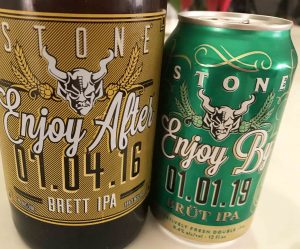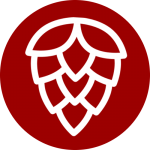If you are a Beer Appreciator you probably like the bold, hoppy IPA style. After all, according to the Brewers Association, it’s the most popular craft beer style in the US. Nearly 3/4 of the growth in craft in 2017 was from the many varieties of the IPA style.
We looked at the last “new IPA” – the hazy, juicy New England style – in my article last August. Here we are again, less than five month later looking at the yet another new IPA style wave rolling out over the country, this time the bone dry “Brut” IPA.
Why is craft beer IPA in particularly so “faddish”? One obvious reason is that today’s beer drinkers want to continually try something new – almost all of the time. Well gone are the days when a beer drinker was a “Miller man” or in the realm of craft beer, one that continually goes back to the same brewery and beer style over and over.
Dick Cantwell, one of the most thoughtful and prolific craft beer leaders (and co-founder of the original Elysian Brewery, educator, writer, speaker) told me once at a Craft Brewers Conference: “I don’t want to be jaundiced – but everyone wants to be and do somethings new”. Well, IPA’s styles are a great canvas for a brewer to start something new – as the IPA style is popular and has the room for lots of interpretations and original ideas.
Sticking with Dick’s influence for a moment, in early 2018 he came out with the book “Brewing Eclectic IPA’s (Pushing the Boundaries of India Pale Ale)”. In this very interesting and enjoyable read, Dick explores of the style starting with its origins and ending with an exhortation to take chances and that the rest is “entirely up to you”. He looks at it from a brewers perspective and as the beer consumer as well. In that book – published less than a year ago, he lists over a dozen IPA styles including those with fruit, vegetables, herbs, spices, chocolate, tea, wood and souring additions.
In passing he mentions the growing interest in “hazy New England IPA’s” but nothing is mentioned of an IPA like the new “Brut” style. In fact, he considers the very idea of creating an IPA style with no discernible malt flavor to balance the hop bitterness “beyond the pale”. (Though he does suggest that maybe it’s an idea yet to come!)
“There are those that believe that IPA’s are entirely about hops, and in some cases literally there is no such thing as too bitter or hoppy a beer. (I’ll let that one just stand there in its absurdity,) All successful beers are about balance, and to play down the contribution of the malt, even for a beer style known for it’s hops, is to go into our examination [of IPA’s] one eyed. Come to think of it, maybe that’s the idea.”
So lets get to the new “Bruts” – what are they and where did they come from? Brut IPA is named to suggest that the brew is dry like champagne. To create a very dry, virtually clear and sparkling IPA, the brewer has to get rid of most all of the residual sugars, starches and proteins that remain in the finished beer. For most craft brews these sugars and starches are sourced from the barley malt used to create the “mash” or wort which is the basis of the unfermented beer. As we all know, you just add the right yeast and off it goes eating the sugars and converting them to alcohol and CO2, and “voila” you have beer.

OK – Only directionally correct – but just a concept of an IPA map – Some IPA’s are both malty and bitter…
But, no matter how voracious the yeast, they don’t eat all of the sugars, and in fact there are whole lots of sugars that are resistant to brewers yeast. These are sometimes are even added to sweeten beers like stouts and New England IPA’s. An example is lactose (milk sugar). There are some pretty hungry yeast strains out there – California’s “Pac Man” as an example, but even they can’t drive out all the sugar to create a “zero gravity” super dry brew like champagne.
But, there is an enzyme – which has long been added in some portion to beer to either create “light beer style” or take some of the sweetness out of other heavily malty beer styles like “Imperial Stouts”. This enzyme is know as this tongue twister: “amyloglucosidase”.
In San Francisco, intrepid brewer Kim Sturdavant from “The Social Kitchen & Brewery” had used the enzyme before, but in November 2017 he decided to try it on a traditional IPA recipe, and just like that the Brut IPA style was born.
Being a craft brewer and all, instead of hoarding this new style to himself, Kim shared it with his other local brewers, and soon everyone wanted to try brewing it. Was this purposely an opposite reaction to the “super sweet” New England IPA? Well, maybe not exactly, but the beer appreciating public may think so, based on the style’s rapid growth and popularity. In January 2019 – just a little more than a year from Brut’s conception – there are some 566 entries for “Brut IPA” the web site Beer Advocate’s listing.
Entering the Brut club this year are some of the larger breweries – unlike with the New England style, this time the West Coast came first. You could find Brut IPA from many smaller west coast breweries and later Sierra Nevada, Stone and Colorado’s New Belgium and now even New England’s Sam Adams has one.
I was fortunate enough to sample the still unnamed “test batch” of Sierra Nevada’s Brut at a “City Tap House” in Washington DC back early November. I really liked the crisp dry – but distinctly IPA hoppiness it offered. I have to admit that I am tired of the usual 9% to 11% Double IPA’s – they are starting to taste like carbonated hop syrup to me. And while the New England style is a nice break from that malty intensity – it’s really a bit sweet for my taste. Welcome you Bruts! (Stone’s “Enjoy by Brut” clocking in at 9.4 abv was a tad harsh for my taste – but that’s what makes IPA styles so fun – the diversity).
Will this be a lasting style? One measure of that is to see if the style makes the Brewer’s Association’s Style guide, like the New England “hazy” IPA did last year. We will have to see.
When I bought the aforementioned book “Brewing the Eclectic IPA” Dick Cantwell kindly signed it for me – and along with his signature he put there: “Old guard meets new ideas”. He was also right about that, as was his closing of his book – that it’s up to the brewer and IPA consumer to figure out what is the next style. Is Brut the next lasting IPA wave? I don’t know, but I look forward to finding out.







